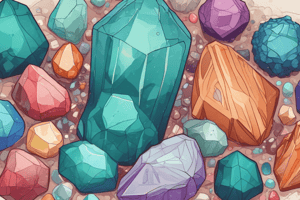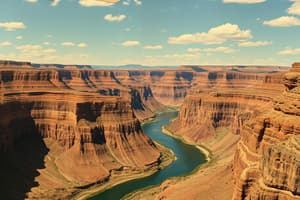Podcast
Questions and Answers
What characteristic of gems indicates the distances they may have travelled?
What characteristic of gems indicates the distances they may have travelled?
- Color variations
- Size and weight
- Crystal structure
- Abraded surfaces (correct)
How are residual gem deposits described?
How are residual gem deposits described?
- Glacial
- Eluvial (correct)
- Alluvial
- Volcanic
What is the main objective of the mining techniques described for gem recovery?
What is the main objective of the mining techniques described for gem recovery?
- Creating tunnels for exploration
- Washing gems with chemicals
- Separating gems from lighter materials (correct)
- Transporting gems to factories
What is the maximum depth for the round or square section pits used in alluvial gem mining mentioned?
What is the maximum depth for the round or square section pits used in alluvial gem mining mentioned?
Which term refers to the gravel that is dug out during the gem mining process in Myanmar?
Which term refers to the gravel that is dug out during the gem mining process in Myanmar?
Who wrote one of the first gemstone books in English?
Who wrote one of the first gemstone books in English?
What operation is commonly used to separate gems from gravel in alluvial mining?
What operation is commonly used to separate gems from gravel in alluvial mining?
Which mining method is NOT mentioned as part of the diamond mining process?
Which mining method is NOT mentioned as part of the diamond mining process?
In what year did the first attempt at gemstone synthesis occur?
In what year did the first attempt at gemstone synthesis occur?
What was a significant outcome of Sir Arthur Church's experiments in 1866?
What was a significant outcome of Sir Arthur Church's experiments in 1866?
What happens to the lighter gravel content during the washing operation described?
What happens to the lighter gravel content during the washing operation described?
Which town was named after the British Secretary for the Colonies in 1873?
Which town was named after the British Secretary for the Colonies in 1873?
What was a characteristic of the first synthetic rubies produced by Edmond Fremy in 1877?
What was a characteristic of the first synthetic rubies produced by Edmond Fremy in 1877?
What new gem variety was discovered in 1878?
What new gem variety was discovered in 1878?
What was the significant contribution of Basil Anderson in 1932?
What was the significant contribution of Basil Anderson in 1932?
What was a notable feature of the 'Geneva' rubies that appeared in 1885?
What was a notable feature of the 'Geneva' rubies that appeared in 1885?
What is the characteristic feature of an axis of symmetry in a crystal?
What is the characteristic feature of an axis of symmetry in a crystal?
What is the role of the plane of symmetry in a crystal?
What is the role of the plane of symmetry in a crystal?
What is the highest order of symmetry associated with the cubic crystal system?
What is the highest order of symmetry associated with the cubic crystal system?
How is a centre of symmetry defined in relation to a crystal?
How is a centre of symmetry defined in relation to a crystal?
What is characteristic of the crystal axes in the cubic system?
What is characteristic of the crystal axes in the cubic system?
Which type of symmetry does a cube have relating to its planes?
Which type of symmetry does a cube have relating to its planes?
Which term describes axes of symmetry that may be classified as diagonal, trigonal, tetragonal, or hexagonal?
Which term describes axes of symmetry that may be classified as diagonal, trigonal, tetragonal, or hexagonal?
What color is specifically designated to Rubies?
What color is specifically designated to Rubies?
Which mineral possesses a prismatic habit and lacks basal cleavage?
Which mineral possesses a prismatic habit and lacks basal cleavage?
Which variation of Sapphire is noted for its barrel shape?
Which variation of Sapphire is noted for its barrel shape?
Which mineral system does Diamond belong to?
Which mineral system does Diamond belong to?
Which of the following colors is not a color associated with Diamond?
Which of the following colors is not a color associated with Diamond?
Which mineral is recognized for displaying horizontal striations?
Which mineral is recognized for displaying horizontal striations?
What is the unique characteristic of Microcline among its varieties?
What is the unique characteristic of Microcline among its varieties?
Fluorite is classified under which crystal system?
Fluorite is classified under which crystal system?
Which characteristic is distinctive of Rhombohedron forms?
Which characteristic is distinctive of Rhombohedron forms?
What color is Plagioclase Feldspar known to exhibit?
What color is Plagioclase Feldspar known to exhibit?
Which material is described as a mineraloid despite resembling a mineral?
Which material is described as a mineraloid despite resembling a mineral?
What characterizes the arrangement of atoms in crystalline materials?
What characterizes the arrangement of atoms in crystalline materials?
What is the primary factor that influences the physical characteristics of crystalline materials?
What is the primary factor that influences the physical characteristics of crystalline materials?
In crystal symmetry, what does the axis of symmetry represent?
In crystal symmetry, what does the axis of symmetry represent?
Which of the following is NOT a characteristic of the cubic crystal system?
Which of the following is NOT a characteristic of the cubic crystal system?
What is crystallography primarily concerned with?
What is crystallography primarily concerned with?
Which property varies with direction only in crystalline materials?
Which property varies with direction only in crystalline materials?
What shape is typically associated with the tetragonal crystal system?
What shape is typically associated with the tetragonal crystal system?
Which of the following statements about man-made glass is true?
Which of the following statements about man-made glass is true?
How many planes of symmetry does the cubic crystal system have?
How many planes of symmetry does the cubic crystal system have?
What happens during the crystallization of materials from molten solutions?
What happens during the crystallization of materials from molten solutions?
What defines the c-axis in a crystal system?
What defines the c-axis in a crystal system?
What type of symmetry is indicated by a mirror plane?
What type of symmetry is indicated by a mirror plane?
Which crystal system is identified by having axes of symmetry amounting to 5?
Which crystal system is identified by having axes of symmetry amounting to 5?
Study Notes
Gemstone History and Development
- Thomas Nichols authored one of the earliest gemstone books in English in 1652.
- Gemmology developed as a specialized field from mineralogy in the late 19th century.
Milestones in Gemstone Synthesis and Study
- In 1837, Marc Gaudin synthesized small ruby crystals using potassium aluminium sulfate and potassium chromate.
- The 1800s saw a surge in crystalline substance reproduction, including utilizing lower melting point solvents.
- Sir Arthur Church discovered absorption bands in Ceylon zircons and almandine garnets using an early spectroscope in 1866.
- Basil Anderson conducted a comprehensive spectrum study of gemstones for identification in 1932.
- The South African diamond rush began after Church's findings, with 5,000 diggers active on the Vaal, Modder, and Orange rivers.
- Kimberley, named after the Earl of Kimberley, emerged in 1873 due to diamond mining activity.
- Edmond Fremy created the first synthetic rubies of commercial quality in 1877, but production was costly and the crystals were small.
- The discovery of green demantoid garnet marked a notable new gem variety in 1878.
Gem Formation and Transportation
- Gem deposits are categorized by their locality, influenced by geological conditions favoring gemstone formation.
- Evidence indicates the distances traveled by gems from their parent rocks can lead to unique surface characteristics, such as water-worn topaz.
Mining Techniques
- Gem recovery methods vary from manual techniques to advanced mechanized operations.
- In Myanmar and Sri Lanka, miners excavate pits up to 15 meters deep to reach gem gravel.
- Dense gem material is separated from lighter sand using a hand-washing technique in woven baskets.
- Diamond mining employs varying methods from simple panning to extensive open-cast operations.
Crystal Symmetry and Axes
- Crystal identification relies on the analysis of symmetry and axes of symmetry, which include:
- Axis of symmetry: Imaginary lines indicating how many times a crystal's profile appears during a full rotation.
- Plane of symmetry: An imaginary plane dividing a crystal into mirror-image halves.
- Centre of symmetry: When crystal faces occur identically across a central point.
Seven Crystal Systems
- Crystals organize into seven systems based on symmetry and crystal axes:
- Cubic (Isometric): Highest symmetry with three equal axes intersecting at 90°. Common forms include cube and octahedron.
- Tetragonal: Two equal lateral axes with the c-axis at 90° and differing lengths.
Properties of Crystalline Materials
- Crystalline materials are defined by their structured atomic arrangements and exhibit properties varying with crystal orientation.
- Notable properties include hardness, cleavage, color, and optical effects, which can fluctuate by direction.
- Crystallography studies the arrangement and behavior of atoms in crystal forms.
Common Gem Varieties and Their Characteristics
- Ruby: Red corundum variant; growth habits include triangular and tabular forms.
- Sapphire: Any corundum color except red; features variable shapes and growth marks.
- Danburite: Orthorhombic system; found colorless, yellow, or brownish.
- Diamond: Cubic system; presents in various colors including colorless, yellow, and rare pink or red.
- Feldspar: Includes varieties like transparent Adularia, yellow Moonstone, and multi-colored Labradorite.
Notes on Man-made and Natural Materials
- Man-made glass lacks the symmetrical atomic arrangement seen in natural gemstones due to rapid cooling processes.
Studying That Suits You
Use AI to generate personalized quizzes and flashcards to suit your learning preferences.
Description
Explore the fascinating evolution of gemmology from its early days in the 17th century to significant advancements in the 19th century. This quiz highlights key milestones in the study of gemstones, including early literature and technological breakthroughs. Test your knowledge about the important figures and developments in the field of gemmology.





